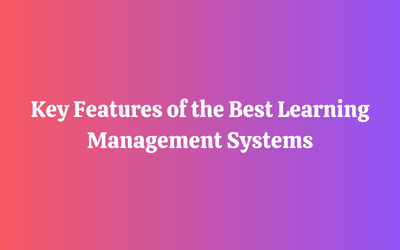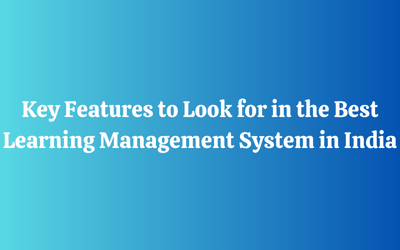What Is LMS? A Comprehensive Guide to Learning Management Systems
Understanding how we learn and manage training has evolved significantly, thanks to technology. A Learning Management System (LMS) is at the heart of this transformation, offering a streamlined way to create, deliver, and track educational or training programs. Whether it’s for corporate training or academic purposes, an LMS provides a digital framework that makes learning more efficient and accessible.
With features like progress tracking, interactive tools, and seamless integration, an LMS ensures learners stay engaged while meeting their goals. Organisations use these platforms not only to enhance skills but also to ensure compliance with regulations and improve productivity. As industries increasingly rely on tailored training solutions, the role of an LMS has become indispensable in fostering growth and development.
What Is LMS?
An LMS, or Learning Management System, is a software application designed to facilitate the creation, delivery, and management of training programs and educational courses. It acts as a centralised platform where organisations can manage learning courses, track learner progress, and assess performance metrics efficiently.
Most LMSs feature tools for administrators to design customised content while enabling learners to access interactive resources like videos, discussions, and assessments. By leveraging AI-driven insights and smart technologies, these systems create personalised learning paths tailored to individual needs.
Key Components of an LMS
An LMS comprises core elements designed to support effective learning management:
- Server Infrastructure: The server underpins the platform by hosting databases, managing user accounts, storing content, and processing data securely.
- User Interface (UI): The UI provides learners with intuitive navigation to access courses while enabling administrators to perform tasks like enrolment or progress monitoring.
- Learning Content Management: Administrators upload course materials such as text documents, videos, quizzes, and assignments to create cohesive training programs or curriculums.
- Data Analytics Engine: This component collects information on learner behaviors and training outcomes for reporting purposes.
These components work collectively to ensure smooth functionality across diverse devices.

Common Features of an LMS
Most modern LMSs offer features tailored for both administrators and learners:
- Responsive Design: Platforms adapt automatically for desktops, tablets, or smartphones so users can access content anytime.
- Course Management Tools: Instructors structure courses using modules with built-in assessment options like quizzes or practical tasks.
- Progress Tracking & Reporting: Dashboards show real-time learner performance metrics for individuals or groups.
- Interactive Features: Tools such as discussion forums or video conferencing foster collaboration among participants.
- Compliance Monitoring: Systems track mandatory certifications or training completions relevant in corporate environments.
By utilising these features effectively, organisations enhance how they plan and deliver educational initiatives.
What Is an LMS Used For?
An LMS serves as a centralised platform for managing diverse learning and training needs. Organisations utilise it to streamline processes, improve accessibility, and enhance learner engagement across multiple use cases.
Employee Training and Onboarding
Organisations rely on an LMS to onboard new employees effectively and provide ongoing training opportunities. It enables HR teams to create tailored development plans, automate course assignments, and track employee progress in real time. For instance, new hires can access orientation modules through any device, ensuring consistency in onboarding experiences regardless of location.
Compliance and Certification Training
Compliance with industry regulations is essential for organisations in areas like healthcare or cybersecurity. An LMS simplifies compliance training by automating reminders for mandatory sessions, hosting updated regulatory content centrally, and generating digital certificates upon completion of required modules.
Customer and Partner Training
Businesses leverage LMSs to train customers on products or services while upskilling partners for better collaboration. Through structured learning paths featuring tutorials or FAQs stored within the platform, users gain confidence in their knowledge base. Software companies often employ this method to teach clients how specific tools work, reducing churn rates while improving satisfaction levels among end-users.
Blended and Remote Learning
Blended learning combines classroom instruction with online resources facilitated by an LMS. Educators use these platforms to enrich traditional teaching methods with videos or quizzes accessible remotely via mobile devices. Additionally, remote learners benefit from discussion forums that promote peer-to-peer interaction alongside instructor-led guidance—bridging geographical gaps while managing engagement.
Benefits of Using an LMS
An LMS offers significant advantages for both organisations and learners, making it a valuable tool for managing education and training programmes. Its ability to centralise learning content and track progress ensures more streamlined processes and better outcomes.
For Organisations
Organisations benefit from using an LMS by improving efficiency in training management. With a centralised platform, all eLearning materials are stored in one location, simplifying updates and reducing redundancy. This eliminates repetitive tasks like manual enrolments or certifications.
Using an LMS reduces the time required to create and deliver training resources by offering pre-built templates, interactive tools, and automation features. Costs associated with classroom-based training, such as venue hire or printed materials, decrease significantly when digital platforms replace traditional methods.
Performance monitoring becomes seamless with detailed analytics on learner engagement, course completion rates, compliance tracking, and skill development metrics. These insights help measure the effectiveness of training programmes while supporting data-driven improvements.
For Learners
Learners enjoy flexibility with 24/7 access to courses on any internet-connected device. Self-paced modules allow individuals to learn at their convenience without being restricted by fixed schedules or locations.
Interactive quizzes and assignments improve engagement while reinforcing knowledge retention. Personalised learning paths cater to each learner’s specific needs using AI-driven recommendations based on their performance data.
Progress tracking tools empower learners to review reports detailing their achievements or areas requiring improvement. Reduced dependency on instructors fosters independent learning while still providing structured guidance throughout the process.
How to Choose the Right LMS
Selecting an LMS involves aligning its features with organisational goals and user needs. To ensure a successful choice, several critical factors should be evaluated.
Evaluating Features and Requirements
Organisations need to assess their key objectives and workflows before exploring LMS features. For instance, if onboarding is a priority, then they must look for platforms that offer custom learning paths and effective progress tracking. Scalability is essential; an ideal LMS accommodates future growth without compromising performance. Additionally, integration capabilities with existing software (e.g., HRMS or CRM systems) streamline operations while maintaining data integrity.
Testing and Reviewing LMS Solutions
Before committing to any system, organisations must request demos to evaluate usability firsthand. During testing phases, both administrators and end-users should interact with the platform extensively to identify potential challenges in navigation or functionality gaps relative to workplace demands. Feedback from stakeholders ensures informed decisions that align closely with operational goals whilst enhancing overall adoption rates post-implementation.
Final Word
Today’s Learning Management Systems do more than host content—they transform how organizations train, upskill, and grow. By centralizing learning, automating admin tasks, and offering real-time analytics, a modern LMS simplifies complexity while maximizing impact.
Whether you’re reimagining corporate training or upgrading academic delivery, the right LMS helps you scale with ease, personalise learning journeys, and drive measurable outcomes. Evaluate our goals, match them with platform capabilities, and unlock a future-ready learning ecosystem that fuels continuous success.
Our News
- AI
- Animations
- Articulate
- Articulate 360
- Articulate Engage
- Articulate Live
- Articulate Presenter
- Articulate Quizmaker
- Articulate Replay
- Articulate Review
- Articulate Storyline
- Articulate Storyline 3
- Articulate Studio
- bite sized learning
- Characters
- Content Library
- Corporate Communication
- E-Learning
- e-Learning Authoring Tools
- Employee Engagement
- Game-Based Learning
- Gamification
- Gamiflexer
- Go Sales
- Healthcare
- Instructional Design
- Interactivity
- Knowledge Transfer
- L&D Trends
- Learning
- Learning & Development
- Learning Experience platform
- Learning Management System
- LMS
- LXP
- Microlearning
- mLearning
- Mobile Learning
- Nugget Learning
- Online Training
- Peek
- Performance Support
- Preso
- Quiz and Assessment Platform
- Replay 360
- Rise
- SCORM
- Screen Capture
- Software
- Storyline 360
- Studio 360
- Training Management
- Trainings
- Uncategorized




